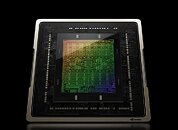- Joined
- Oct 9, 2007
- Messages
- 47,890 (7.38/day)
- Location
- Dublin, Ireland
| System Name | RBMK-1000 |
|---|---|
| Processor | AMD Ryzen 7 5700G |
| Motherboard | Gigabyte B550 AORUS Elite V2 |
| Cooling | DeepCool Gammax L240 V2 |
| Memory | 2x 16GB DDR4-3200 |
| Video Card(s) | Galax RTX 4070 Ti EX |
| Storage | Samsung 990 1TB |
| Display(s) | BenQ 1440p 60 Hz 27-inch |
| Case | Corsair Carbide 100R |
| Audio Device(s) | ASUS SupremeFX S1220A |
| Power Supply | Cooler Master MWE Gold 650W |
| Mouse | ASUS ROG Strix Impact |
| Keyboard | Gamdias Hermes E2 |
| Software | Windows 11 Pro |
The AD102 silicon on which NVIDIA's new flagship graphics card, the GeForce RTX 4090, is based, is a marvel of semiconductor engineering. Built on the 4 nm EUV (TSMC 4N) silicon fabrication process, the chip has a gargantuan transistor-count of 76.3 billion, a nearly 170% increase over the previous GA102, and a die-size of 608 mm², which is in fact smaller than the 628 mm² die-area of the GA102. This is thanks to TSMC 4N offering nearly thrice the transistor-density of the Samsung 8LPP node on which the GA102 is based.
The AD102 physically features 18,432 CUDA cores, 568 fourth-generation Tensor cores, and 142 third-generation RT cores. The streaming multiprocessors (SM) come with special components that enable the Shader Execution Reordering optimization, which has a significant performance impact on both raster- and ray traced graphics rendering performance. The silicon supports up to 24 GB of GDDR6X or up to 48 GB of GDDR6+ECC memory (the latter will be seen in the RTX Ada professional-visualization card), across a 384-bit wide memory bus. There are 568 TMUs, and a mammoth 192 ROPs on the silicon.

The RTX 4090 is carved out of this silicon by enabling 16,384 out of 18,432 CUDA cores. 512 out of 568 Tensor cores, 512 out of 568 TMUs, 128 out of 142 RT cores, and unless NVIDIA has touched the ROP count, it could remain at 192. The memory bus is maxed out, with 24 GB of 21 Gbps GDDR6X memory across the 384-bit bus-width. In creating the RTX 4090, NVIDIA has given itself a 10% headroom in the number-crunching machinery, from which to carve out future SKUs such as the possible RTX 4090 Ti. Until that SKU is needed in the product-stack, NVIDIA will use this 10% margin toward harvesting the AD102 silicon.
View at TechPowerUp Main Site
The AD102 physically features 18,432 CUDA cores, 568 fourth-generation Tensor cores, and 142 third-generation RT cores. The streaming multiprocessors (SM) come with special components that enable the Shader Execution Reordering optimization, which has a significant performance impact on both raster- and ray traced graphics rendering performance. The silicon supports up to 24 GB of GDDR6X or up to 48 GB of GDDR6+ECC memory (the latter will be seen in the RTX Ada professional-visualization card), across a 384-bit wide memory bus. There are 568 TMUs, and a mammoth 192 ROPs on the silicon.

The RTX 4090 is carved out of this silicon by enabling 16,384 out of 18,432 CUDA cores. 512 out of 568 Tensor cores, 512 out of 568 TMUs, 128 out of 142 RT cores, and unless NVIDIA has touched the ROP count, it could remain at 192. The memory bus is maxed out, with 24 GB of 21 Gbps GDDR6X memory across the 384-bit bus-width. In creating the RTX 4090, NVIDIA has given itself a 10% headroom in the number-crunching machinery, from which to carve out future SKUs such as the possible RTX 4090 Ti. Until that SKU is needed in the product-stack, NVIDIA will use this 10% margin toward harvesting the AD102 silicon.
View at TechPowerUp Main Site






 - Thats why they said bye bye Nvidia
- Thats why they said bye bye Nvidia

